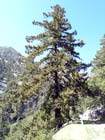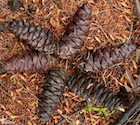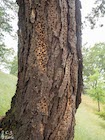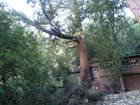
Trees, foliage and cones. Drawing by Matt Strieby, 2018.

Typical stand of P. macrocarpa on Palomar Mountain [C.J. Earle, 2012.12.20].

Tree, ca. 100 cm dbh and 20 m tall, growing by the highway ca. 6 km above the town of Mt. Baldy [C.J. Earle, 2004.04.13].

Ripe pollen cones and foliage on the tree shown above [C.J. Earle, 2004.04.13].

Emerging foliage on a tree N of Crestline [C.J. Earle, 2019.05.23].

First-year seed cones on the tree show above [C.J. Earle, 2004.04.13].

Seed cone, collected in Banner Canyon near Julian; length about 15 cm [C.J. Earle, 2004.04.08].

Representative selection of 6 cones collected N of Crestline [C.J. Earle, 2019.05.23].

Bark on a tree ca. 80 cm dbh, with extensive mining by acorn woodpeckers [C.J. Earle, 2019.05.23].

Ring structure on a cut section with ca. 50 cm radius; tree grew in town of Mt. Baldy [C.J. Earle, 2004.04.14].

The largest known specimen of P. macrocarpa, in the town of Mt. Baldy [C.J. Earle, 2004.04.14].

Conservation Status

Pseudotsuga macrocarpa
(Vasey) Mayr 1889
Common names
Bigcone Douglas-fir, bigcone spruce (Peattie 1950). As a member of the genus Pseudotsuga, it is not a spruce, but "bigcone spruce" is the name you will usually hear if you travel in this tree's native range.
Taxonomic notes
Synonymy (Farjon 1998):
- Abies macrocarpa Vasey 1876
- Abies douglasii (Sabine ex D.Don) Lindl. var. macrocarpa (Vasey) Vasey 1876
- Pseudotsuga douglasii (Sabine ex D.Don) Carrière var. macrocarpa (Vasey) Engelmann 1880
- Tsuga macrocarpa (Vasey) Lemmon 1898
- Pseudotsuga californica Flous 1934
- Pseudotsuga menziesii (Mirb.) Franco subsp. macrocarpa (Vasey) E. Murray 1982
Description
When the seed cones are not in evidence, it generally resembles interior Douglas fir (P. menziesii subsp. glauca) in bark and foliage characters, and somewhat in growth form; however, the species do not co-occur in their native habitats. It forms a tree that commonly attains 30 m height and 100 cm dbh, with a roughly conical crown that often bears some deformation due to the dry sites, poor soils and frequent fire that this tree must frequently contend with. The twigs are slender, glabrous or pubescent. The needles are (20-)25-45 × 1-1.5 mm, bluish green, with a mucronate tip. The pollen cones are pale yellow. The very distinctive seed cones are 9-20 × 4-7 cm; the bracts are often, but not always, exserted in the mature dry cone. Seeds are 9-12 mm long. 2n=24 (pers. obs. and Lipscomb 1993). See García Esteban et al. (2004) for a detailed characterization of the wood anatomy.
Distribution and Ecology
USA: California, at 200-2400 m elevation. Habitat slopes, cliffs, and canyons, in chaparral and mixed conifer forests. The northernmost stands of the species, in Kern County, are about 35 kilometers east of the closest approach of P. menziesii (Lipscomb 1993). Hardy to Zone 8 (cold hardiness limit between -12.1°C and -6.7°C) (Bannister and Neuner 2001). See also Thompson et al. (1999).
Native distribution of Pseudotsuga; P. macrocarpa in blue. Distribution data from GBIF, 2021.02.22.
This is a common species in the Coulter pine (Pinus coulteri)—Hardwood phase of California mixed conifer forests, typically found on steep N-facing slopes and in ravines, i.e., sites with relatively low fire frequency. At the lowest elevations (c. 1100 m) it occurs as scattered individuals 15-30 m tall above a closed canopy of Quercus chrysolepis. At higher elevations (c. 1500 m) it becomes much more abundant (80-190 trees/ha) in a mixed Pseudotsuga-Quercus canopy. Although often codominant with Pinus coulteri and Quercus chrysolepis, it is typically found on relatively more mesic sites with lower fire frequency. Not surprisingly, then, it is also found in riparian habitats as a codominant with mesic hardwood species such as Acer macrophyllum and Populus trichocarpa (Barbour 1988).
Lanner (1999) reports that the tree typically survives fire, which is a common hazard since it often grows amid chaparral. The fire may scorch the needles from the branches, but epicormic buds soon sprout from upper branch surfaces and unburned trunks, and a tree that looked dead may soon return to full vigor.
Remarkable Specimens
The official national champion was 217 cm dbh and 50.3 m tall with a 28.7 m crown spread when measured in 2015 (American Forests 2021). It grows in the town of Mount Baldy, California. This tree (see photo) has been the species champion since 1945 and has been named "Old Glory." With its roots in a perennial stream and the care of its human neighbors, it should be around and growing for many years yet. I last saw it in 2019. The second-largest specimen, in the Pleasant View Ridge Wilderness, was found and documented by Michael Kauffmann in 2015; it was then 214 cm dbh and 36.0 m tall, with a crown spread of 34.75 m, thus, nearly the equal of the champion tree.
The oldest known living specimen, 658 years, was documented in a tree-ring chronology covering the period 1336-1993 (crossdated after 1441), collected northeast of Santa Barbara, California by Dave Meko and Franco Biondi (doi.org/10.25921/r42m-jw76).
Ethnobotany
Although of no concern for timber, the species is valuable for esthetics and watershed protection (Lipscomb 1993).
The species is useful in dendrochronology; about 20 chronologies have been developed, most of them used in a study of air pollution impacts on tree growth.
A nice shot of a Pseudotsuga macrocarpa stand opens Stanley Kubrick's 1953 film Fear and Desire.
Observations
Fairly easy to locate within its range. It is quite common in mixed pine-chaparral habitats of the San Gabriel Mountains just N of Los Angeles (CA), along CA Hwy 243 W of Mt. San Jacinto, and probably in many other pine-chaparral habitats of the Transverse Ranges. The largest specimen is in the town of Mt. Baldy, CA, growing in sight of Los Angeles (on days when the smog is not too bad), and the trail up Mt. San Antonio from the town of Mt. Baldy provides ample opportunities to observe this tree in habitat. It lines parts of Banner Canyon near Julian, CA; this is about the southernmost distribution of the species.
Remarks
The epithet and the common name both refer to the cones, which are larger than those of any other species in the genus.
The uncommonly large seeds surely have limited dispersal potential when driven by moderate winds; one wonders if birds or small mammals play a role in their dispersal.
Citations
American Forests 2021. 2021 National Register of Champion Trees. Washington, DC: American Forests.
Barbour, M. G. 1988. Californian upland forests and woodlands. P. 131-164 in Barbour, M.G. and W.D. Billings. North American Terrestrial Vegetation. Cambridge: Cambridge University Press.
Mayr, H. 1889. Die Waldungen von Nord-amerika, ihre Holzarten, deren Anbaufahigkeit und forstlichen Wert fur Europa... Munchen. P. 278, plates 6, 8, 9. [1890 on title plate, but published late 1889.]
See also
Burns and Honkala (1990).
Howard (1992) at the Fire Effects Information System database provides a thorough ecological review.
Minnich (1982) asks, is there Pseudotsuga macrocarpa in Baja California? Although the answer to the question is "no", this article provides an engaging discussion of the distribution and ecological associations of the species.
Sargent (1898) provides an exceptionally detailed description of this species, with an excellent illustration.










